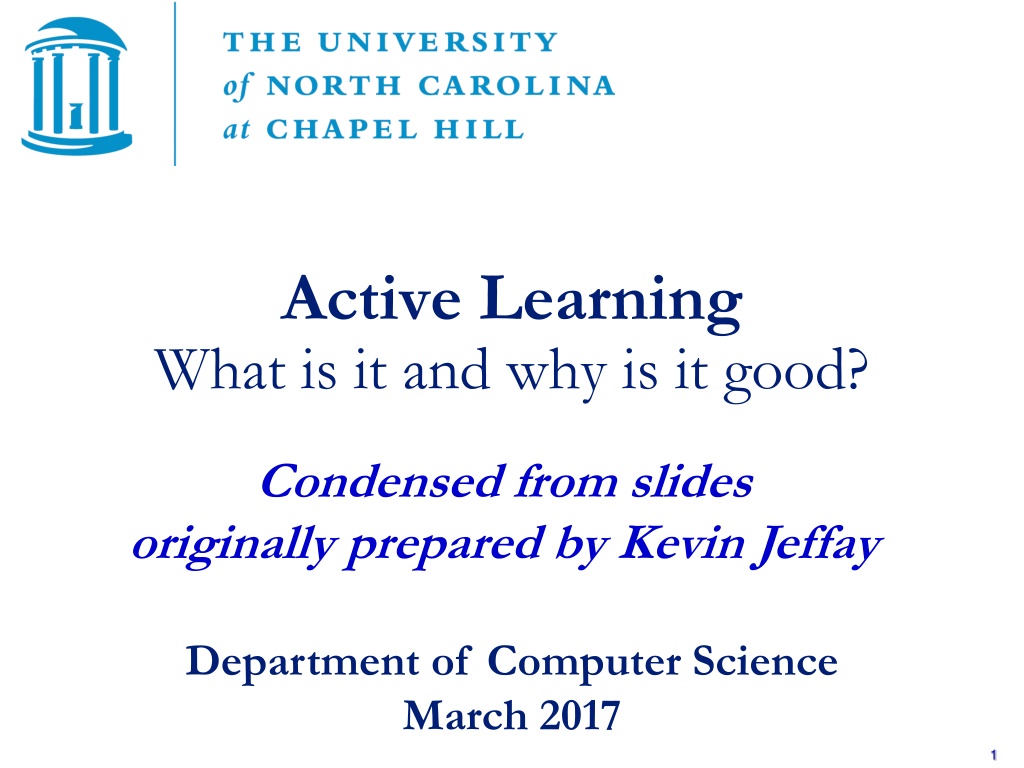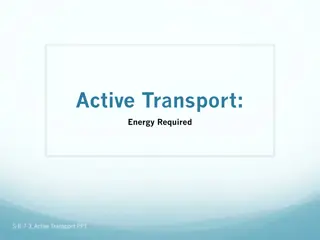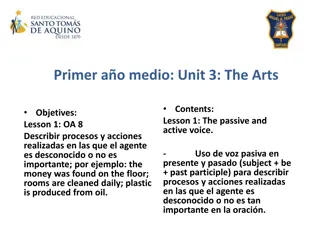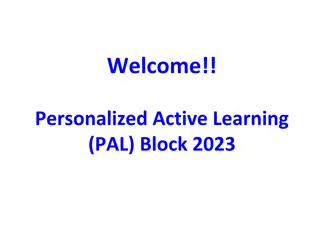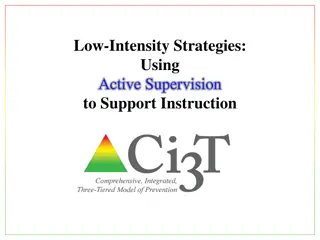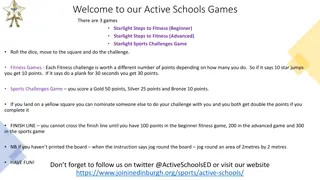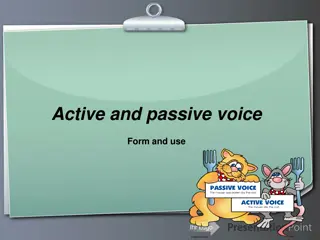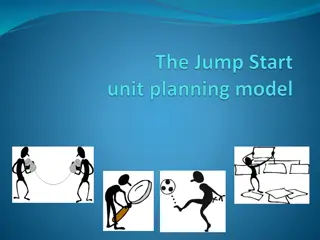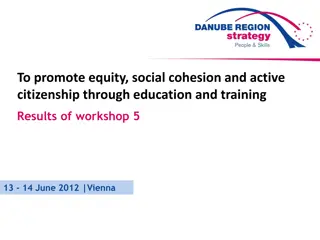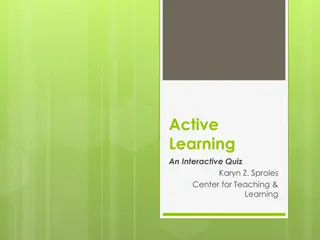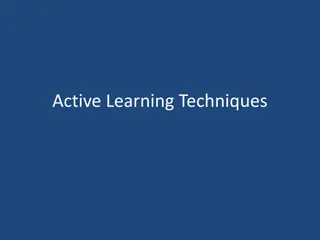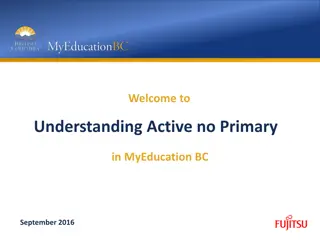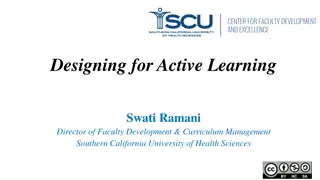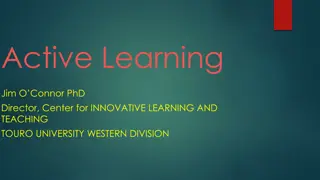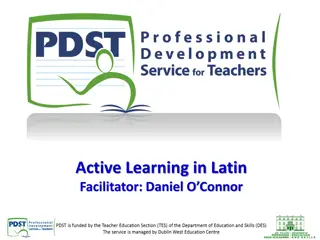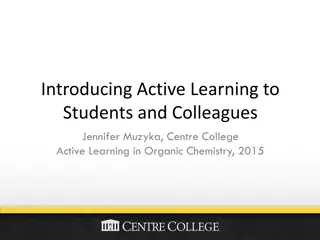Understanding Active Learning in Education
Active learning engages students in the learning process by encouraging participation and critical thinking. Examples include class discussions, think-pair-share activities, and learning cells, fostering collaboration and intellectual growth. Instructors play a vital role in guiding discussions, promoting diverse perspectives, and enhancing student engagement. Active learning benefits students by developing analytical skills, encouraging interaction, and fostering a deeper understanding of course materials.
Download Presentation

Please find below an Image/Link to download the presentation.
The content on the website is provided AS IS for your information and personal use only. It may not be sold, licensed, or shared on other websites without obtaining consent from the author. Download presentation by click this link. If you encounter any issues during the download, it is possible that the publisher has removed the file from their server.
E N D
Presentation Transcript
Active Learning What is it and why is it good? Condensed from slides originally prepared by Kevin Jeffay Department of Computer Science March 2017 1
Active Learning (The Theory) Active learning is a method of learning in which students are actively or experientially involved in the learning process and where there are different levels of active learning, depending on student involvement In active learning, students participate in the learning process Students participate when they are doing something besides passively listening 2
Example Active Learning Exercises Class discussion A discussion may be held in person or in an online environment Discussions can be conducted with any class size, although it is typically more effective in smaller group settings. Discussion allows for instructor guidance of the learning experience Discussion requires the learners to think critically on the subject matter and use logic to evaluate their and others' positions. As learners are expected to discuss material constructively and intelligently, a discussion is a good follow-up activity given the unit has been sufficiently covered already. Discussion helps students explore a diversity of perspectives, increases intellectual agility, shows respect for students voices and experiences, develops habits of collaborative learning, and helps students develop skills of synthesis and integration By having the teacher actively engage with the students, it allows students to come to class better prepared and aware of what is taking place in the classroom 3
Example Active Learning Exercises Think-pair-share A think-pair-share activity is when learners take a minute to ponder the previous lesson, later to discuss it with one or more of their peers, finally to share it with the class as part of a formal discussion A think-pair-share exercise is useful in situations where learners can identify and relate what they already know to others Prepare learners with sound instruction before expecting them to discuss it on their own. The method is useful for teachers to hear from all students even those who are quiet in class This teaching method functions as a great way for all the students in the class to get involved and learn to work together and feel comfortable sharing ideas. This is not a good strategy to use in large classes because of time and logistical constraints 4
Example Active Learning Exercises Learning cell A learning cell is a process of learning where two students alternate asking and answering questions on commonly read materials To prepare for the assignment, the students read the assignment and write down questions that they have about the reading At the next class meeting, the teacher randomly puts students in pairs The process begins by designating one student from each group to begin by asking one of their questions to the other Once the two students discuss the question, the other student ask a question and they alternate accordingly During this time, the teacher goes from group to group giving feedback and answering questions 5
Example Active Learning Exercises Short written exercises A short written exercise that is often used is the one-minute paper This is a good way to review materials and provide feedback However a one-minute paper does not take one minute and for students to concisely summarize it is suggested that they have at least 10 minutes to work on this exercise 6
Example Active Learning Exercises Collaborative Learning group A collaborative learning group is where you assign students in groups of 3-6 people and they are given an assignment or task to work on together This assignment could be either to answer a question to present to the entire class or a project Make sure that the students in the group choose a leader and a note-taker to keep them on track with the process This is a good example of active learning because it causes the students to review the work that is being required at an earlier time to participate. (McKinney, Kathleen. (2010). Active Learning. Normal, IL. Center for Teaching, Learning & Technology.) To create participation and draw on the wisdom of all the learners the classroom arrangement needs to be flexible seating to allow for the creation of small groups 7
Example Active Learning Exercises Student debate A studentdebate is an active way for students to learn because they allow students the chance to take a position and gather information to support their view and explain it to others. These debates not only give the student a chance to participate in a fun activity but it also lets them gain some experience with giving a verbal presentation. (McKinney, Kathleen. (2010). Active Learning. Normal, IL. Center for Teaching, Learning & Technology.) 8
Example Active Learning Exercises Small group discussion A small group discussion is also an example of active learning because it allows students to express themselves in the classroom. It is more likely for students to participate in small group discussions than in a normal classroom lecture because they are in a more comfortable setting amongst their peers, and from a sheer numbers perspective, by dividing the students up more students get opportunities to speak out. There are so many different ways a teacher can integrate small group discussion into the class, such as making a game out of it, a competition, or an assignment. Statistics show that small group discussions is more beneficial to students than large group discussions when it comes to participation, expressing thoughts, understanding issues, applying issues, and overall status of knowledge 9
Example Active Learning Exercises Class game A class game is also considered an energetic way to learn because it not only helps the students to review the course material before a big exam but it helps them to enjoy learning about a topic Different games such as Jeopardy! and crossword puzzles always seem to get the students' minds going 10
Example Active Learning Exercises Learning by teaching Learning by teaching is also an example of active learning because students actively research a topic and prepare the information so that they can teach it to the class This helps students learn their own topic even better and sometimes students learn and communicate better with their peers than their teachers 11
The Inverted Classroom A typical approach: Watch videos of the lectures Active problem solving in class No out of class homework! 12
Does Active Learning Work? If you do some googling, you ll find lots of articles like this one that say yes. Some interesting quotes from this article: For decades, there has been evidence that classroom techniques designed to get students to participate in the learning process produces better educational outcomes at virtually all levels. [A cited study] shows that, though students felt as if they learned more through traditional lectures, they actually learned more when taking part in classrooms that employed so-called active-learning strategies. Deep learning is hard work. The effort involved in active learning can be misinterpreted as a sign of poor learning, [an expert] said. On the other hand, a superstar lecturer can explain things in such a way as to make students feel like they are learning more than they actually are. You can find all sorts of articles full of graphs, data, etc., that indicate that active learning is demonstrably effective. 13
Your Experiences? Have you taken an inverted classroom course? Did it work for you? What other active learning approaches have you encountered that were effective? Ineffective? 14
